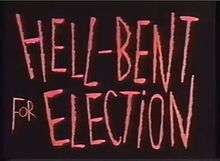Hell-Bent for Election
Hell-Bent For Election is a 1944 two-reel (thirteen minute) animated cartoon short subject film.[1][2]
| Hell-Bent For Election | |
|---|---|
 | |
| Directed by | Charles M. Jones |
| Produced by |
|
| Story by | E.Y. Harburg (lyrics) |
| Starring | Marvin Miller (narration) Frank Graham (Joe) |
| Music by | Earl Robinson |
| Animation by |
|
| Color process | Technicolor |
Production company | |
| Distributed by | United Auto Workers |
Release date |
|
Running time | 13 mins (two reels) |
| Language | English |
The short was one of the first major films from United Productions of America (then known as "Industrial Films"), which would go on to become the most influential animation studio of the 1950s. As UPA did not have a full staff or a studio location until the late-1940s, this film was made in animator Zack Schwartz's apartment with the help of moonlighters from various local Hollywood animation studios. Among the moonlighters was Chuck Jones, who directed the film.[3][4]
Plot
The film is an allegorical campaign film, designed to inspire viewers to register and to vote for Franklin D. Roosevelt. The Democratic Party candidate, Roosevelt, is depicted as a modern streamlined steam train engine, the "Win the War Special", pulling a high-speed freight train of war material, whereas his Republican opponent Thomas E. Dewey is depicted as an old creaky steam train engine, the "Defeatist Limited" (numbered 1929 as a nod to the 1929 stock market crash) pulling cars variously representing hot air, high prices, taxes, business as usual (a sleeper car), poor housing for war workers, a hearse wagon for labor legislation, a small two-wheel cart with just a few apples inside for unemployment insurance, and finally a caboose named "Jim Crow."[5]
The conflict in the film centers on Joe, a railroad switch operator who represents the American voting public. He is warned by the station master, Sam (a representation of Uncle Sam), not to fall asleep at the switch as he did in November 1942. Joe must then decide whether to listen to the influence of a cigar smoking gnome-like Dewey supporter and wrecker who tries to make him fall asleep at the switch, or to fight that influence and make sure that the Roosevelt "Win the War Special" stays on the track towards Washington. At one point, the phantasmagoric saboteur briefly metamorphosizes into Adolf Hitler whilst trying to beguile Joe into neglecting his duties. After a notable nightmare sequence, in which Joe fights his way through sales taxes (tacks), 'frozen' wages, and rising prices (depicted by a boxcar always increasing in height so that he is never able to climb on to the roof), he pulls the switch to sideline the Defeatist Limited. The train tries to stop by running into reverse, which damages many of its cars, but when he is not able to slow down and hitting the switch which is against him, the train engine and his cars derail and crash. The "Win the War Special" advances down the track toward Washington, full steam ahead.
The film ends with a paean to the bountiful post-war world to come; the Win the War Special's caboose is the "Post War Observation Car", and constituencies such as Joe Soldier, Joe Farmer, J. Industrialist, Joe Industrialist, Jr., and Joe Worker are shown examining fold-out brochures depicting the benefits of the American post-war world, including the benefits of the GI Bill and Social Security.[6]
Analysis
Hell-Bent for Election is a far more literal film than later UPA productions such as Gerald McBoing Boing and the Mr. Magoo shorts. Nevertheless, its strong symbolism, non-literal design styles, and unusual camera angles made the short stand out among its peers.
The film was sponsored by United Auto Workers, and features a song, "We're Going to Win the War", written by Earl Robinson and E.Y. Harburg, the latter famous for writing the lyrics for The Wizard of Oz. Hell-Bent for Election was UPA's first major success, and paved the way for its later achievements, including nine nominations and three wins for the Academy Awards Best Animated Short Film.
The short focuses on contrasting attitudes toward World War II, with the contest between the "Win the War Special" (representing Roosevelt) and the "Defeatist Ltd" (representing Dewey).[7] The argument between Joe and The Wrecker refers to the War and attitudes toward it. Joe argues that "we" [Americans] are out to win the war, while The Wrecker snarls that this is Roosevelt's war. As he says that, the Wrecker transforms into a caricature of Adolf Hitler.[7] Joe's dream features a billboard depicting Adolf Hitler, Benito Mussolini, and a Japanese caricature.[7] Joe's awakening results in him sending the munitions-laden Special on its run toward victory.[7] The "Post War Observation Car" displays veterans' benefits and full employment as post-war goals.[7]
Sources
- Shull, Michael S.; Wilt, David E. (2004). "Filmography 1944". Doing Their Bit: Wartime American Animated Short Films, 1939–1945. Jefferson, NC: McFarland & Company. ISBN 978-0-7864-8169-9.
See also
References
- Amazon.com
- Saved from the flames. Persuade me (eVideo,2008)-WorldCat
- Hell-Bent For Election (1944) Theatrical Cartoon-BCDB
- MUBI
- Internet Archive
- Shull, Wilt (2004), p. 169–170
External links
- The short film Hell-Bent for Election is available for free download at the Internet Archive
- Hell-Bent for Election on IMDb
- Hell-Bent for Election on YouTube